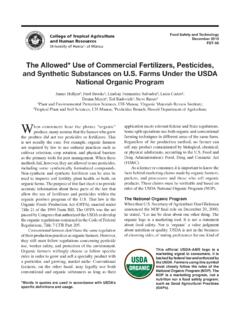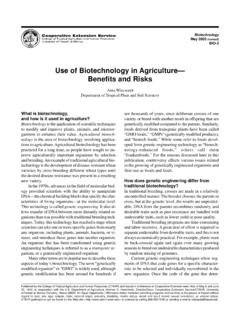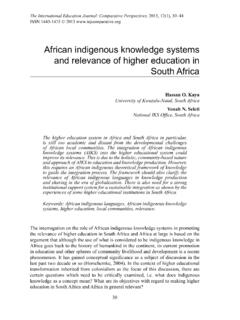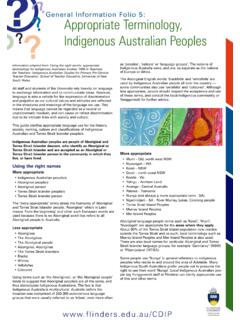Transcription of Natural Farming: The Development of Indigenous ...
1 Sustainable Agriculture February 2019SA-19 Published by the College of Tropical Agriculture and Human Resources (CTAHR) and issued in furtherance of Cooperative Extension work, Acts of May 8 and June 30, 1914, in co-operation with the Department of Agriculture, under the Director/Dean, Cooperative Extension Service/CTAHR, University of Hawai i at M noa, Honolulu, Hawai i 96822. Copyright 2018, University of Hawai i. For reproduction and use permission, contact the CTAHR Office of Communication Services, 808-956-7036. The university is an equal opportunity/affirmative action institution providing programs and services to the people of Hawai i without regard to race, sex, gender identity and expression, age, religion, color, national origin, ancestry, disability, marital status, arrest and court record, sexual orientation, or status as a covered veteran.
2 Find CTAHR publications at Farming: The Development of Indigenous Microorganisms Using Korean Natural Farming MethodsA. Keliikuli,1 K. Smith,2 Y. L i ,1 and Lee11 Department of Human Nutrition, Food and Animal Sciences2 Hoa ina O M kaha FarmContact: Lee Natural farming is a self-sufficient farming system that involves the culturing of Indigenous mi-croorganisms (IMO) bacteria, fungi, nematodes, and protozoa in place of inorganic fertilizers to produce fertile soil. The culturing and nurturing of Indigenous microorganisms is discussed in this publication. Follow-ing the guidelines documented in Cho s Natural Farm-ing, this publication outlines the protocol, materials, and methods used to culture IMO on a 5-acre farm located in Makaha, Hawai i (2010).
3 The materials, methods, and collection sites used to culture IMO may vary from farm to farm, due in part to locality and availability of materials. However, the overall concept of culturing IMO remains the same. In addition, an attempt to quantify the related costs was made to provide some guidance for interested plays a vital role in our ecosystem; without it, life for many multicellular organisms would cease to exist. In addition, food shortages are driven by soil degradation, as poor farming practices lead to loss of nutrients through erosion and leaching (Tilman et al. 2002). To maximize crop yield, it is imperative that farmers maintain a healthy environment for plants to grow, as the quality of the soil can change the outcome of the harvest.
4 The most common way to replenish the soil is by adding fertilizer to it. However, the maintenance of fertile soil does not come cheap. Fertilizers and other soil additives can be expensive, especially in Hawai i, due to the higher costs of shipping. It is vital that Hawai i s farmers minimize costs wherever possible. Korean Natural farming (KNF) has been proposed as an attractive alternative for farmers who wish to become less dependent on external inputs without sacrificing crop yield (Hoon and Park 2010).KNF is a sustainable farming system developed by Master Han Kyu Cho from Janong Natural Farming Institute in South Korea. It has been practiced for over 40 years throughout Asia. KNF is a self-sufficient sys-tem that involves culturing Indigenous microorganisms (IMO) fungi, bacteria, and protozoa and reintroduc-ing them into nutrient-depleted soil, thus enhancing soil microbial activity and fertility (Essoyan 2011).
5 There is a symbiotic relationship that occurs between plants and beneficial IMOs; the microorganisms convert nutrients into a form that the plant is able to absorb. In turn, the plants provide food to these microorganisms. This type of closed-loop farming system maximizes the use of on-farm resources and recycles farm waste while at the same time minimizing external inputs. KNF is a multifaceted system that adapts to local conditions (Cho 2010). Introduced to Hawai i in 1999, KNF is gaining popularity among farmers in Hawai i who are interested in sustainable agriculture (Wang et al. 2012). Farmers who practice this farming method believe that UH CTAHRK orean Natural Farming: Development of Indigenous Microoganisms SA-19 Feb.
6 20192it minimizes their dependence on inorganic fertilizers and pesticides. However, little scientific documentation of the benefits of these practices exists as yet (Park and Duponte 2010).ObjectivesThe objectives for this study were to a) identify some of the resources readily available on a farm site that can be used for the Development of IMO, b) demonstrate the chronological Development of IMO, and c) provide some estimates of cost and time for the process of developing IMO. This publication outlines the steps used to collect IMO from a farm in Makaha, Hawai i. For a detailed guide on how to collect and cultivate Indigenous micro-organisms using traditional methods, refer to Cho s book Natural Farming (2010).Materials and MethodsKNF involves a four-step process of capturing, cultivat-ing, and preserving Indigenous microorganisms (IMO).
7 These four steps create products that are often referred to as IMO 1, IMO 2, IMO 3, and IMO 4. As previously mentioned, the process of collecting and culturing mi-croorganisms may vary farm to farm due to locality and availability of materials and supplies. However, the principle remains the same. The following materials were used for the collection and culturing of IMOs. x x (1 x 1 x ft.) lauhala box withcover (a cedar box, plastic container, or ceramicbowl are alternatives) 340 g (2 cups) of steamed white rice (preferably onthe dry side) 20L bucket with holes drilled on the sides (refer toIMO InputsCharacteristicsAmount added per kg of wheat mill runLactic Acid BacteriaAbundant in the whey from yogurt and cheese-making, or can be culti-vated with rice wash water (saved from the first rinse of rice in preparation for cooking))
8 And unpasteurized mlOriental Herbal NutrientLicorice, angelica, ginger, garlic, and cinnamon are the ingredients used in the preparation of mlFermented Plant JuiceFPJ is made by taking the growing tips of healthy plants vegetables, herbs, or weeds, mixing them with brown sugar, and allowing them to mlFish Amino AcidA liquid made from fish waste. Similar to Asian fish sauce used in food preparation, but without the added salt, it is made by mixing fish parts with brown sugar and letting the mixture ferment for a few months. 15 mlWater-Soluble CalciumMade from roasted eggshells soaked in BRV (brown rice vinegar).15 mlSeawaterDiluted with fresh water; used to add minerals, for soil treatment before seeding, and to enhance ripening of porous charcoal.
9 Provides a storehouse for all the nutrients and bucketTable 1. Natural inputs used to make the IMO (Cho 2010)3UH CTAHRK orean Natural Farming: Development of Indigenous Microoganisms SA-19 Feb. 2019 Figure 1b and 1c) Small mixing container Large (4L) glass jar Twine Semipermeable material (paper towel, cloth, can-vas) Brown sugar (570 g) kg bag of wheat mill run Shovel Mixing container 20L of fishpond water Measuring spoon (15 ml; 1 tablespoon) Natural inputs (refer to Table 1)Making IMO 1 Collecting IMOThe first step to making IMO is to locate an area to collect the microbes. The preferred site to collect IMO is near the rhizosphere of plants whose roots contain sugar. According to Master Cho and other Korean Natural farmers, plants in the Bambusoideae (bamboo) family are the ideal choice, as their roots contain a high amount of sugar (Cho and Cho 2010).
10 These sugars attract bacterial-dominated microbes and nematodes. In addi-tion to bamboo, broadleaf trees and leaf molds are other commonly used sites (Cho and Cho 2010). Three specific sites on the farm were selected to collect microbes: near 1) bamboo plant, 2) Artocarpus altilis (breadfruit tree),and 3) Leucaena leucocephala (haole koa tree). Hence,three separate batches of IMO were made by utilizingthree different collection sites. The following procedureoutlines the collection and cultivation of microbes frombamboo (Figure 1a).The lauhala box was filled 1/3 full with hard-cooked rice (use less water to cut back on the amount of mois-ture). The main goal here is to provide the microbes with a food source. The lauhala cover was placed back onto the box.















